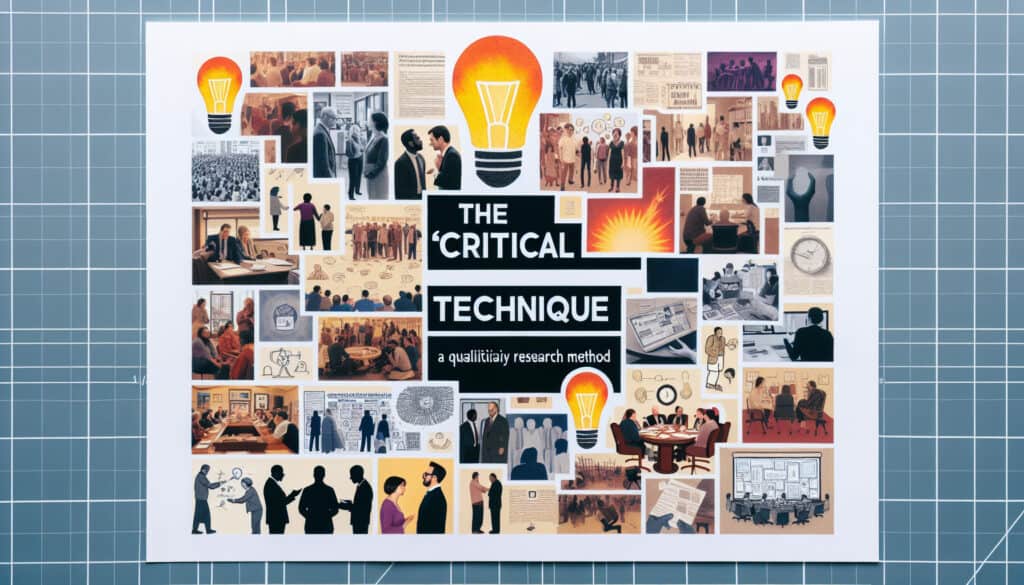بحث نوعي الطريقة التي تتضمن جمع معلومات مفصّلة حول العالم الواقعي الهام الأحداث (الحوادث) من المراقبين أو المشاركين.
- المنهجيات: العملاء والتسويق, الاقتصاد
تقنية الحوادث الحرجة

تقنية الحوادث الحرجة
- التحسين المستمر, التصميم لسداسية سيجما (DfSS), التفكير التصميمي, التفاعل بين الإنسان والحاسوب, إدارة الجودة, سهولة الاستخدام, اختبار قابلية الاستخدام, تجربة المستخدم (UX), تصميم يركز على المستخدم
الهدف:
كيفية استخدامه:
- ويطلب القائمون على المقابلات من المستخدمين أو الموظفين وصف حالات محددة اختبروا فيها نتيجة إيجابية أو سلبية بشكل خاص أثناء أداء مهمة ما، إلى جانب السياق والعواقب.
الايجابيات
- يجمع بيانات غنية ومحددة السياق حول سلوكيات ومشاكل المستخدمين في العالم الحقيقي؛ ويساعد في تحديد العوامل الرئيسية التي تؤدي إلى النجاح أو الفشل؛ ويقدم أمثلة محددة لتحسين التصميم أو التدريب.
سلبيات
- تعتمد على ذاكرة المشاركين، والتي يمكن أن تكون غير دقيقة أو متحيزة؛ قد تكون الحوادث نادرة ولا تمثل الاستخدام المعتاد؛ يمكن أن يستغرق تحليل البيانات النوعية وقتًا طويلاً.
الفئات:
- بيئة العمل, الموارد البشرية, تصميم المنتج, الجودة
الأفضل لـ
- فهم العوامل الرئيسية التي تساهم في تحقيق نتائج ناجحة أو غير ناجحة في تفاعل المستخدم مع النظام.
تقنية الحوادث الحرجة (CIT) قابلة للتكيف بشكل خاص في أبحاث تجربة المستخدم، واختبار قابلية الاستخدام، وتقييمات الإنتاجية في مكان العمل في مختلف القطاعات، بما في ذلك الرعاية الصحية والتعليم وتطوير البرمجيات وخدمة العملاء. وغالباً ما يتم استخدام المنهجية خلال مراحل المشروع المبكرة لإبلاغ قرارات التصميم أو خلال مراحل الاختبار التكراري لتحسين الأنظمة الحالية. عادة، يمكن أن يقود بدء منهجية تجربة المستخدم باحثو تجربة المستخدم أو مصممو المنتجات أو مهندسو العوامل البشرية الذين يسعون إلى جمع بيانات نوعية مفصلة مباشرة من المستخدمين أو الموظفين. والمشاركون في هذه المنهجية هم في المقام الأول مستخدمو المنتج أو النظام المعني، وكذلك الموظفون الذين يتفاعلون مع العملية، ويقدمون رؤى حقيقية حول تجاربهم. ومن الأمثلة على التطبيق في قطاع الرعاية الصحية إجراء مقابلات مع الممرضين والممرضات حول الحوادث الحرجة التي واجهوها أثناء استخدام أنظمة السجلات الصحية الإلكترونية، والتي يمكن أن تكشف عن عوامل محورية إما تعزز أو تقوض رعاية المرضى بسبب مشاكل في قابلية الاستخدام. ومن خلال توثيق كل من الحوادث الإيجابية والسلبية على حد سواء، يمكن للفرق أن تؤسس فهمًا واضحًا للحواجز النظامية والاستراتيجيات الناجحة التي تؤدي إلى تحسين تفاعلات المستخدم، وبالتالي وضع أساس لتحسينات التصميم المستهدفة ومبادرات التدريب. تتيح البيانات الغنية في العالم الحقيقي التي يتم الحصول عليها من خلال تكنولوجيا المعلومات والاتصالات للمؤسسات اتخاذ قرارات مستنيرة تستند إلى تجارب المستخدم الفعلية بدلاً من الافتراضات أو الملاحظات المعممة.
الخطوات الرئيسية لهذه المنهجية
- تحديد مهام أو تفاعلات محددة للتحقق منها.
- مطالبة المستخدمين أو الموظفين بتذكر الحوادث المهمة المتعلقة بتلك المهام.
- شجع على توضيح سياق كل حادثة.
- اسأل عن تفاصيل حول نتائج وعواقب الحوادث.
- استكشاف مشاعر المستخدم وأفكاره أثناء الحادث.
- طلب توضيح ما الذي ساهم في نجاح أو فشل الموقف.
- تحليل الحوادث التي تم جمعها بحثاً عن المواضيع والأنماط المشتركة.
- تحديد أولويات العوامل المحددة بناءً على تأثيرها على تجربة المستخدم.
نصائح للمحترفين
- استفد من أسئلة المتابعة الاستقصائية للتعمق أكثر في السياق العاطفي والظرفي للحوادث المبلغ عنها، مما يثري فهم دوافع المستخدمين وردود أفعالهم.
- الاستفادة من التحليل الموضوعي للحوادث التي تم جمعها للكشف عن الأنماط والاتجاهات الأساسية التي يمكن أن تسترشد بها خيارات التصميم والتدخلات التدريبية.
- دمج مصادر بيانات متعددة الوسائط (على سبيل المثال، بيانات الملاحظة، وتحليل المهام) إلى جانب المقابلات التي تُجرى مع الحوادث للتحقق من صحة النتائج والكشف عن التناقضات بين تجارب المستخدم المتصورة والفعلية.
لقراءة عدة منهجيات ومقارنتها, نوصي باستخدام
> مستودع المنهجيات الشامل <
مع أكثر من 400 منهجية أخرى.
نرحب بتعليقاتكم على هذه المنهجية أو المعلومات الإضافية على قسم التعليقات أدناه ↓، وكذلك أي أفكار أو روابط متعلقة بالهندسة.
السياق التاريخي
1962
1970
1972
1980
1980
1986
1986
1960
1963
1970
1980
1980
1980
1986
1987
(إذا كان التاريخ غير معروف أو غير ذي صلة، على سبيل المثال "ميكانيكا الموائع"، يتم تقديم تقدير تقريبي لظهوره الملحوظ)















منشورات ذات صلة
جدول الإنتاج الرئيسي (MPS)
التخصيص الشامل
قمع التسويق
التدقيق التسويقي
مؤشر MAPO (حركة ومساعدة مرضى المستشفيات)
تخطيط موارد التصنيع (MRP II)